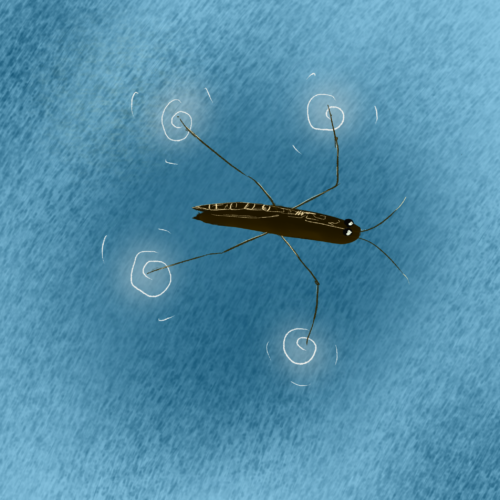Art Courtesy of Patricia Joseph.
Over a still pond, a raindrop falls on a line of water striders. It engulfs one of the insects, launching it upward amid a water jet. Momentarily the water strider is airborne—then the jet collapses and whips back up. The bug is left submerged, twisting just beneath the glassy surface.
The Gerridae insect family has long drawn scientists’ fascination with its unusual water-walking abilities. But how these bugs fare on turbulent seas has just been uncovered in a new study by a team of physicists from Florida Polytechnic University. Led by assistant professor of mechanical engineering Daren Watson, researchers captured on stunning video how water striders survive simulated rain drops. After plunging subsurface with their water-repellent coat, they rise back upward atop a jetstream. When a second collision pulls the bugs underwater, they paddle along with swift strokes.
As a result, these tiny striders can weather a violent rainstorm—an insight that surprisingly may extend to how microplastics persist in marine environments.
“I think it’s my best work yet,” Watson said. “We’ve answered a fundamental question, but there’s much to explore in studies to come.”
Watson’s foray into aquatic insects began on his Florida campus, where he found himself curious about the bugs skimming across his local pools. He couldn’t understand how their millimeters-long bodies could survive a free-falling drop, much less a storm. “[As] opposed to us humans, these insects have nowhere to hide,” Watson said.
With a little guidance from the “Bug Closet” at the University of Central Florida and a lot of scouring from nearby ponds, Watson captured and reared a group of water striders in a mini aquarium. He placed twenty of these insects in a chamber with an elevated nozzle and syringe pump. To simulate rainfall, he directed water from the nozzle through a long, narrow channel, landing droplets one at a time onto the bugs.
After some tinkering and tailoring, the results—rendered in crystal-clear, 3,200 frames-per-second video resolution—reveal a valiant battle by the Gerridae. While some scatter and leap away at an impending raindrop, a bug caught in the splash zone must bear its full brunt.
“The force of the raindrop striking the water strider is significantly higher than the weight of the water strider,” Watson said (up to forty times higher, to be precise—imagine a small delivery truck crashing atop you). “But it does not cause the strider to die.”
Hydrophobic, densely-packed hairs along the bug’s exoskeleton repel the water, forming a bubble, called the first crater, around its body. This crater generates a buoyant force that pulls the water strider back to the surface, then shoots upward as a water jet—which a well-positioned bug can surf like a gentle tidal wave.
But when this jet collapses back downward and forms a second crater, the collision comes faster and harsher. “You can think of it like you’re stretching a rubber band… [it’s] going to rapidly go back to its original position,” Watson said.
As the bug sinks again, the crater retracts so quickly that the swimming creatures struggle to follow. According to Watson’s calculations, if this crater’s acceleration exceeds a threshold value—5.7 times the acceleration due to gravity—it tears away from the insect body, leaving the water strider submerged beneath the cavity.
Though some footage shows intrepid water striders pedaling their legs to come up for air, they do not always succeed. “They must be able to swim and survive below the waterline for a period of time,” Watson said. “And that also adds to their survival during rainfall.”
He wonders if this is an evolutionary predisposition for creatures exposed to rain—why resurface if another drop will come plummeting down seconds later? But as a physicist, Watson is more proud of cracking the mathematics of the second crater’s growth and collapse, something never before reported. Noting water striders’ similarities in size and buoyancy to ocean microplastics, he looks forward to translating his findings toward studying these waterway pollutants.
“When [microplastics] get into our water bodies, how do they become submerged?” he said. “How are they going to be exposed to the fishes, the marine life within those water bodies? How does rainfall precipitate that exposure?”
For now, Watson has moved on from sea critters and back toward his realm of inanimate objects, though his study has opened new doors for biologists and engineers alike. In the meantime, across the swamps of Florida, water striders continue to twist and swirl beneath our marine surfaces, braving the onslaught of rain.

